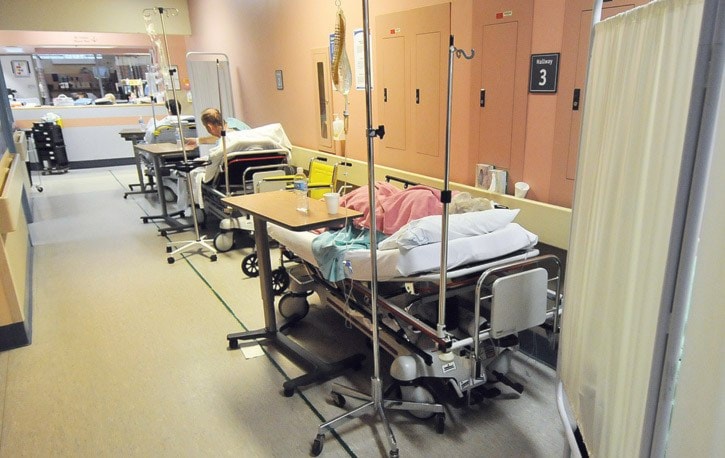Canada is back. Back, that is, to staged B��Ԫ������ַ�negotiationsB��Ԫ������ַ� between Ottawa and the provinces that end up with policies unilaterally imposed by Ottawa.
The return of this time-worn charade was best revealed when provincial environment ministers convened recently with Catherine McKenna, CanadaB��Ԫ������ַ�s minister of environment and climate change.

As B.C. Environment Minister Mary Polak and others were pulling up their chairs, Prime Minister Justin Trudeau rose from his in the House of Commons and announced his escalating B��Ԫ������ַ�carbon priceB��Ԫ������ַ� policy will be imposed on provinces if they donB��Ԫ������ַ�t do it voluntarily. Some provincial ministers walked out.
Then it was the turn of health ministers. To avoid another ugly scene in front of TV cameras, federal Health Minister Jane Philpott let it be known well before the meeting that the free-spending Trudeau government will be keeping the Stephen Harper governmentB��Ԫ������ַ�s restricted formula for health transfer payments.
Two of HarperB��Ԫ������ַ�s many sins were refusing to conduct fake negotiations with premiers in areas of federal jurisdiction, and rolling back annual increases in health care transfers from six per cent each year to about half of that.
Harper sent his finance minister, the late Jim Flaherty, all the way out to Victoria in 2011 to break the news. The formula, in response to an extended period of low economic growth and low inflation, also ends targeted funding for selected wait-listed surgical procedures and bases transfers on population only.
When it was announced, provinces east of Saskatchewan had anxiety attacks. ManitobaB��Ԫ������ַ�s health minister called it B��Ԫ������ַ�un-Canadian.B��Ԫ������ַ� OntarioB��Ԫ������ַ�s warned that it would B��Ԫ������ַ�destabilize the federation.B��Ԫ������ַ�
Now, as with international climate change policy, Trudeau is carrying on with HarperB��Ԫ������ַ�s plan.
In the 2015 federal election campaign, unions ran ads accusing Harper of a $30 billion B��Ԫ������ַ�cutB��Ԫ������ַ� to health care transfers. This fictitious cut is based on six per cent annual increases that were arbitrarily promised by former Liberal prime minister Paul Martin, and have continued up until this year. Martin called this unsustainable plan to pour in ever-increasing cash B��Ԫ������ַ�fixing health care for a generation.B��Ԫ������ַ�
In his 2015 campaign, Trudeau promised to put an additional $3 billion towards health care, and negotiate a new agreement with provinces. That B��Ԫ������ַ�negotiationB��Ԫ������ַ� is over now.
Oh, and the $3 billion is coming, but it must be spent on home care services. Philpott was under pressure in the House of Commons last week, arguing that the previous Conservative government put lots more money into health care but didnB��Ԫ������ַ�t change the system. It needs to be B��Ԫ������ַ�transformed,B��Ԫ������ַ� she said.
Cue the outrage, in Quebec especially, as Ottawa tries to direct the key provincial jurisdiction of health care.
Philpott, a physician herself, is right. Dr. Granger Avery, the former Port McNeill family doctor who now heads the Canadian Medical Association, agrees.
Indeed, the CMA has long argued that Canada still has a post-war acute care model in a country dominated by chronic care patients.
B.C. Health Minister Terry Lake and his predecessors have argued that the federal formula should account for the share of retirees, who are by far the biggest users of health care.
Nova Scotia health minister Leo Glavine described the situation best last week.
B��Ԫ������ַ�We have the oldest demographic in the country, but when I look at that demographic, the big cohort is 53 to 68,B��Ԫ������ַ� Glavine said. B��Ԫ������ַ�And itB��Ԫ������ַ�s not just the age of the population, it's also a cohort with an extreme number of chronic conditions.B��Ԫ������ַ�
ThatB��Ԫ������ַ�s the real issue. The back end of the baby boom, my generation, is the big end. And we havenB��Ԫ������ַ�t taken good care of ourselves.
Tom Fletcher is B.C. legislature reporter and columnist for Black Press. Email: tfletcher@blackpress.ca Twitter: @tomfletcherbc



